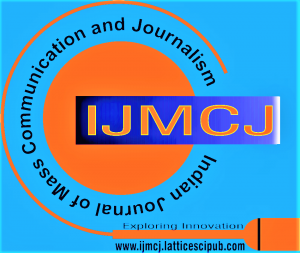![]()
Communication for SDG 3: An Analysis of Strategies and Campaigns of Developmental Agencies in Jharkhand
Shreya Sinni1, Rashmi Verma2, Rajesh Kumar3, Sameera Bhoi4
1Shreya Sinni, Young Professional, Jharkhand State Livelihood Promotion Society, Ranchi (Jharkhand), India.
2Dr. Rashmi Verma, Assistant Professor, Department of Mass Communication, Central University of Jharkhand, Ranchi (Jharkhand), India.
3Dr. Rajesh Kumar, Assistant Professor, Department of Mass Communication, Central University of Jharkhand, Ranchi (Jharkhand), India.
4Sameera Bhoi, Scholar, Department of Mass Communication, Central University of Jharkhand, Ranchi (Jharkhand), India.
Manuscript received on 21 July 2025 | First Revised Manuscript received on 01 August 2025 | Second Revised Manuscript received on 20 August 2025 | Manuscript Accepted on 15 September 2025 | Manuscript published on 30 September 2025 | PP: 35-42 | Volume-5 Issue-1, September 2025 | Retrieval Number: 100.1/ijmcj.A114105010925 | DOI: 10.54105/ijmcj.A1141.05010925
Open Access | Editorial and Publishing Policies | Cite | Zenodo | OJS | Indexing and Abstracting
© The Authors. Published by Lattice Science Publication (LSP). This is an open-access article under the CC-BY-NC-ND license (http://creativecommons.org/licenses/by-nc-nd/4.0/)
Abstract: Effective communication techniques are crucial for promoting health and well-being in developmental efforts aimed at achieving Sustainable Development Goal 3 (SDG 3), particularly in challenging states like Jharkhand, India. This study examines the communication tactics employed by a few Jharkhand-based NGOs and agencies to achieve the goals of Sustainable Development Goal 3, and explores potential implementation issues. The study uses a mixed-method approach and descriptive research design to interview representatives of specific NGOs (Breakthrough, Ekjut, Nischay Foundation, ASHA, CINI, UNICEF) in-depth. Qualitative insights into communication tactics highlight prevalent behaviours, obstacles, and outcomes. The results show that NGOs employ a range of communication tactics, including edutainment, community engagement, and the utilisation of both traditional and digital media. Participation in the community is essential for promoting trust and changing behaviour. Language differences, geographical restrictions, poor infrastructure, and cultural traditions that obstruct health education are among the top challenges.
Keywords: Sustainable Development Goal, NGOs, Jharkhand, Strategies, Campaigns.
Scope of the Article: Social Science
